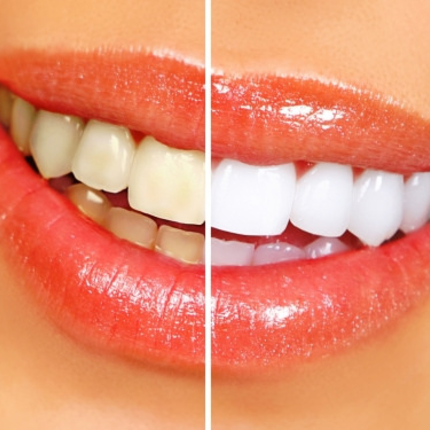When patients come in to our dental practice in Pulborough, they often ask us how they can get whiter teeth. In fact, teeth whiteness is the number one cosmetic concern for our patients. This normally leads to an important follow up question: how do you grade how white someone’s teeth are?
The truth is that no two people’s teeth are identical. Teeth differ not only in shape, but also in shade, darkness, enamel thickness, and many other factors. While there’s no universally recognised system for grading tooth colour, most dentists use a shade guide to determine the exact whiteness of a patient’s smile.
Teeth Shades
The basic structure of a teeth shade guide breaks down into two main factors: teeth shades, and teeth darkness.
Tooth shade refers to the specific base colour, hue, or tint of your teeth, as opposed to how light or dark your teeth are. Everyone’s teeth are slightly different in colour, but most people’s teeth colours can be divided into four main colour categories. These colour categories are typically labelled from A-D.
Here are the four main teeth shades:
- A: reddish brown
- B: reddish yellow
- C: grey
- D: reddish grey
All four colours or shades are equally capable of being white.
Tooth darkness is the second factor by which teeth are graded. Classical teeth shade guides split darkness into four levels, but many modern guides have more finely grained scales with many levels of darkness per shade. The two-axis chart of tooth shade and darkness lets each patient find their unique tooth colour, and helps them create a point of reference once they start undergoing whitening treatments.
What Causes Yellow Teeth and Discolouration?
Discolouration usually takes the form of white streaks, brown spots, and yellow tints. While some stains can be remediated by regular dental care at home, other stains are more permanent and require teeth whitening treatment from a private dentist.
There are several types of tooth discolouration caused by a variety of factors.
- External or extrinsic discolouration refers to stains on the outer layer of teeth. A tooth’s outer layer, known as enamel, can be stained due to excessive tobacco use, eating dark berries, or drinking red wine, dark juices, coffee, fizzy drinks, or other juices with strong dyes.
- Internal or intrinsic discolouration refers to the inside of the teeth acquiring a yellow tint or darker shade. This can be caused by internal bleeding due to physical trauma to the tooth, exposure to excessive fluoride in early childhood, exposure to tetracycline antibiotics in infancy, or certain genetic conditions.
So what can be done to whiten stained or naturally dark teeth?
Teeth Whitening by Shade
There’s no standard recommended level of teeth whiteness, but the teeth shade guide can help patients identify their ideal target and help track progress as their teeth get whiter through treatment.
Keep in mind that there’s no guarantee when it comes to whitening treatments. Depending on the natural colour of your teeth, how severe your teeth’s stains are, and the type of treatment you choose, results can vary widely.
While results will vary from treatment to treatment and patient to patient, most patients who undergo whitening treatments will find that a difference of only two shades will make a noticeable difference in their smile, but teeth can whiten as many as nine shades over the course of treatment.
Teeth Whitening Treatments
First and foremost, all teeth whitening regiments require that you follow best dental care practices at home, including brushing, flossing, and rinsing after every meal. A small change in habits can make a major difference in your smile.
To achieve a white smile, it’s also important that you attend regular professional cleanings at your dentist. Even the most dentally health-conscious of us still need to attend regular professional cleanings to ensure that plaque and tartar don’t build up in harder-to-reach areas.
There are many options when it comes to whitening your teeth, and all treatments are not created equal. There are definite tradeoffs when it comes to time and cost. Some dental offices offer instant laser whitening or potent in-office bleaching treatments, but these treatments tend to be more expensive and more likely to cause tooth sensitivity. Inexpensive home treatments include whitening pens, toothpastes, mouthwash, and strips, although these treatments are often ineffective.
At Vitality Dental, a private dental practice in Pulborough, we employ an effective, non-invasive three-step teeth whitening process using a whitening tray, which lets you gradually whiten your teeth at home over a two-to-three week time period. The process is totally pain free and results in less tooth sensitivity than alternative treatments.
Here’s how the teeth whitening process works:
- In your first appointment, we record the shade of your teeth before beginning treatment. We’ll then make a dental impression of in order to mold a whitening tray that comfortably fits the contours of your teeth.
- In your second visit, we’ll teach you how to use the tray with a special whitening gel that’s configured to your exact whitening needs. You’ll then use this gel to whiten your teeth over a two-to-three week period at home.
- In your final visit, we’ll analyse your final shade. Using a shade guide, you’ll be able to see how far your smile has progressed!
Click here for more information on this three-step teeth whitening treatment.
For more dramatic cases of teeth stains and damage, we also offer dental veneers. Veneers are a natural-looking alternative to whitening and can help give you that healthy and white smile you’ve always wanted.
Tips after Whitening
After you’ve whitened your teeth, it’s important to maintain proper dental hygiene. Avoid stain-causers like coffee, wine, candy, and dyes, and stay away from tobacco.
Your teeth may also be more sensitive for a short time after whitening, so we recommend using sensitivity toothpaste. After treatment, you should avoid using additional at-home whitening techniques, as it’s best to give your teeth some time to rest.
For more information on teeth whitening in Pulborough, West Sussex, contact Vitality Dental today.


